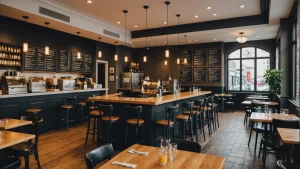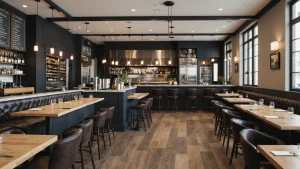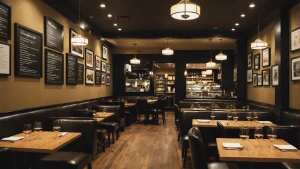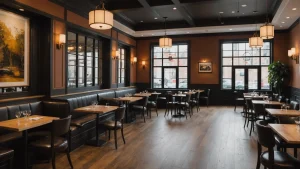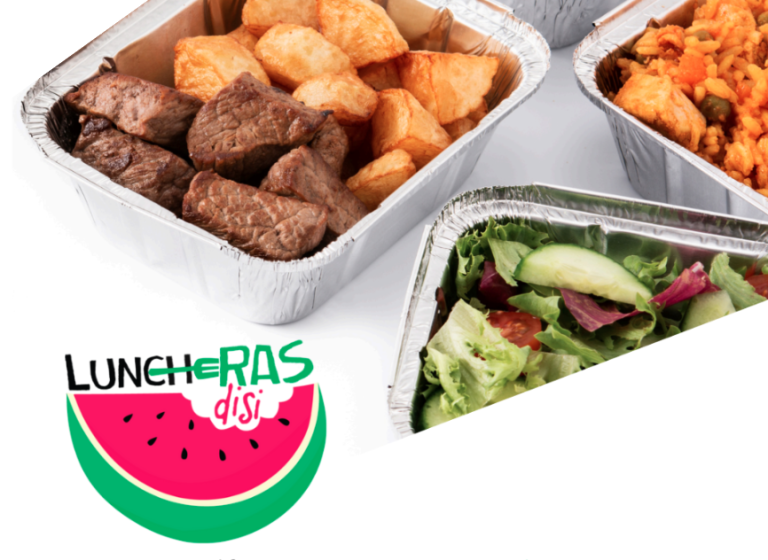Do you want to expand your restaurant in 2024? Franchising could be the best way forward.
This journey isn’t just about replicating your success; it’s about building a lasting business model.
We’ll break down the five key steps: crafting a strong business model, navigating legal waters, leveraging marketing, setting up sound financial plans, and establishing robust training programs. Understanding these steps will guide you in creating an effective plan for your restaurant business, ensuring a roadmap to success in the competitive culinary industry.
It is better to learn how each step can strengthen your brand and increase your reach.
You should avoid common mistakes and pave the path to franchising success.
Franchise Establishments in The U.S.
In 2023, there were approximately 805,500 franchise establishments in the United States, reflecting a steady growth in the industry

Metrobi drivers are rated 4.97 out of 5
Trusted by local businesses for:
- Background-checked professionals
- Specialized in business deliveries
- Same drivers for consistency
- 4.97/5 average delivery rating
How to Franchise a Restaurant – Step 1: Building a Strong Franchise Model
Defining Your Unique Selling Points
First, you must pinpoint what makes your restaurant stand out. Maybe your menu has something few people offer. This could be a special dish or a style of cooking that sets you apart. Alternatively, it might be your service—how you treat your customers differently than competitors. Your branding is an essential tool in defining this uniqueness. Learn how to initiate a restaurant venture, encompassing techniques for developing a successful business strategy, obtaining funding, and selecting an ideal site.
Once identified, these unique selling points should form the backbone of your franchise plan. These elements create not just a restaurant but an experience that people can identify with your brand. For example, if quick service is your strength, make sure this is at the forefront of every new location.
Employees of the Franchise Industry
Over 8.5 million people are employed by franchises across various sectors, highlighting their significant role in job creation
Market Analysis and Research
Analyzing local and national market trends for franchise restaurants is crucial. The franchise sector is growing rapidly, with a forecasted 1.9% increase in establishments to 821,589 units in 2024. The Southeast and Southwest U.S. regions are predicted to see strong growth due to demographic shifts.
When looking at trends, see how they align with your restaurant concept itself. Quick-service restaurants are popular, which could indicate a market for fast-casual dining. You should be aware of what works in your area, and if you’re expanding, understand the different tastes and spending habits in new regions. Interested in executing a soft launch for your dining establishment? Discover the essentials of planning a soft opening for your restaurant and make it a success.
To make informed decisions, research your target customer’s preferences and spending habits. This means diving deep into what customers in existing restaurants in your area love to eat, how much they’re willing to pay, and how often they dine out. Customers’ preferences can vary widely even within the same city, and tapping into analytics can give you a broader view of these habits.
Restaurant Franchising Statistics
States like Texas and Florida are projected to experience the most substantial growth in franchising due to favorable business climates and population increases
Step 2: Understanding Legal Requirements for Restaurant Franchising
-
Legal groundwork ensures your restaurant franchise is protected.
-
Making sure your brand and processes have proper legal backing is key.
-
Clear legal documents help avoid future disputes.
Developing a Restaurant Franchise Disclosure Document (FDD)
The Franchise Disclosure Document (FDD) is the backbone of your new franchise company’s legal setup. This document must be thorough, as it includes 23 sections mandated by the Federal Trade Commission.
Overview of Mandatory Sections in the FDD
The FDD should cover sections like the franchise fee or fees, financial performance, and legal obligations. It provides potential franchisees with a clear understanding of what they’re getting into. Each section is crucial. For instance, Item 19 may include financial performance representations, giving prospects real insights into potential earnings. You should focus on transparency here. Detail the costs involved in setting up a franchise and any royalty fees. Lay out these costs clearly to avoid misunderstandings down the line.
Importance of Clear Terms and Conditions
Clear terms and conditions in the FDD set expectations and responsibilities. Is it mandatory for franchisees to use specific suppliers? If so, it should be laid out in the FDD. In essence, the FDD serves to protect both the franchisor and franchisee from potential legal battles. Ambiguities can lead to disputes, which cost time and money.
Securing Intellectual Property Rights
Intellectual property (IP) is another critical area for restaurant franchisors. Protecting your brand identity safeguards your business from copycats. There are multiple aspects to this, from trademarks to proprietary recipes.
Steps for Trademarking Your Brand
Trademarks cover your restaurant’s name, logo, and even slogans. Securing a trademark ensures no one else can use your brand elements. Trademark registration might seem costly and time-consuming, but it’s a necessary step. For instance, the process includes conducting a trademark search, submitting an application, and sometimes responding to office actions. It’s a process you don’t want to rush. Missteps can result in costly disputes or even losing your brand identity. You should consider enlisting intellectual property attorneys who specialize in franchising.
Protecting Recipes and Proprietary Processes
Aside from the brand, your unique recipes and processes might also need protection. A trade secret designation can prevent competitors from using or stealing your recipes. This involves limiting access to the recipes and requiring non-disclosure agreements from those who know them. You can think about Coca-Cola’s recipe, protected as a trade secret for over a century.
Step 3: Creating Effective Marketing Strategies for Restaurant Industry Franchises
-
Strengthen your restaurant’s presence both online and offline.
-
Consistent brand identity attracts loyal customers.
-
Learn tactics to enhance your marketing impact.
Leveraging Local and Digital Marketing
Combining local efforts with digital marketing is key for restaurant franchises. Local marketing involves promotions that are tailored to the community. This can mean hosting events, offering special deals, or partnering with local businesses. For example, a monthly special that features ingredients from a nearby farm can build community loyalty. Digital marketing complements these efforts by increasing reach and engagement through online channels.
Social Media and Online Reviews
Social media platforms like Instagram and Facebook are powerful tools for promoting the current restaurant around. Regular posts showcasing dishes or events can create buzz. Another essential aspect is engaging with food review platforms. Responding to reviews on platforms like Yelp or Google can improve your restaurant’s image. It shows responsiveness and care for customer feedback. Five-star reviews are crucial for credibility and attracting new customers.
Building a Strong Brand Identity
A consistent and recognizable brand identity is vital across all franchise locations. This creates a cohesive experience for customers, regardless of which restaurant they visit. Every detail of a successful franchise restaurant, from the logo to the uniforms, needs to align with the brand’s values and aesthetics.
Visual Elements
Key visual elements include logos, colors, and slogans, which should be consistent across all touchpoints of the parent company. Even the menu design and signage within the restaurant contribute to the brand identity. These elements help differentiate the franchise and make it easily identifiable. They create an emotional connection with the customers, fostering loyalty.
Print Media and Community Engagement
Print media is not obsolete. Well-designed flyers and brochures in local areas can still capture attention. These can be distributed in strategic locations where potential customers frequently visit. Featuring deals or new menu items can entice people to visit the restaurant.
Local Partnerships
Forming alliances with local businesses can enhance both franchise company’ reach and reputation. Collaborations can range from offering meal discounts to businesses’ employees or participating in community events. Community engagement is also an opportunity for beneficial publicity. Sponsoring local sports teams or school events can ingratiate the franchise into community life.
Franchise Agreements
Franchise agreements typically last between 10 to 20 years, providing stability for both franchisors and franchisees
Analytics and Campaign Adjustments
Regular analysis of marketing campaigns is fundamental to success. By interpreting data, you can understand what works and what doesn’t. This involves tracking social media metrics, online engagements, and foot traffic.
Adjusting Strategies
Metrics from platforms like Google Analytics offer insights into user interaction. This data can inform future campaigns and help tailor them to your target audience. Adjusting strategies based on data is not a one-time event. It is a continuous process necessary to stay relevant. Restaurants can refine their ad spending or social media approach based on performance metrics.
Step 4: Setting Up Financial Planning for Restaurant Franchisees
Clarify the cost structure and funding paths.
Understand revenue models and royalty fees.
Build strong finance strategies aligning with franchise goals.
Initial Investment and Funding Sources
Understanding the costs of starting a restaurant franchise is crucial. The initial investment often includes franchise fees, real estate, equipment, and initial marketing. According to industry statistics, many franchisees struggle as they don’t anticipate hidden startup costs. It’s important to prepare for these investments by making detailed financial projections using tools like profit and loss statements. These show revenue and costs over a given period and provide insight into a business’s financial health. Looking for tools to aid your financial projections? Discover templates for restaurant business plans that can help structure your financial forecasting efforts.
When it comes to funding, franchisees can explore loans, investors, or personal savings. Loans, though traditional, come with interest rates and capital paybacks. Banks often assess the business model, including projected restaurant sales—estimated at $863 billion industry-wide—to determine loan eligibility. It’s vital to ensure cash flow can sustain loan repayment while maintaining operations. Equity financing lets you bring in investors who take a stake in the business. Uncover the fundamental stages to initiate a restaurant venture, emphasizing the importance of a solid financial plan for attracting investments or acquiring loans.
The Franchising Industry
The franchising industry is expected to see a 1.9% increase in the number of establishments from 2023 to 2024
Ongoing Fees and Royalty Structures
Franchisees enter into contracts often involving ongoing fees, crucial for sustaining both franchisee operations and franchisor support. Typically, these fees include royalties, advertising funds, and other service charges. Royalties are usually a percentage of sales, ensuring the franchisor shares in the franchisee’s success. On one hand, this supports franchisors in providing continued marketing efforts, training updates, and operational guidance. On the other hand, fees can pressure franchisees, especially in periods of low revenue. Balancing these fees against projected sales, informed by industry performance benchmarks like Prime Costs, is paramount.
Understanding revenue streams is key. Restaurants with dynamic pricing models may adjust prices based on demand peaks like sports events or adverse weather. Such strategies contribute to sustainability under variable market conditions, aligning with the recommended practice of maintaining a single source of truth for financial performance across locations. This practice allows franchisors to track key metrics like cost of goods sold, rents, and purchases consistently. Grasp the importance of Revenue Per Available Seat Hour (RevPASH) in benchmarking your restaurant’s efficiency and profitability. See how enhancing your RevPASH can drive better financial health.
Step 5: Training and Support Systems for Franchisees
Developing Comprehensive Training Programs
Training is the backbone of any successful restaurant franchise system. It ensures that franchisees not only understand but also embody the ethos of the brand. A robust training program starts with manuals and courses. These resources lay the groundwork for a franchisee’s operational know-how and cultural alignment with the brand. Looking to enhance your restaurant’s functionality? Discover strategies for creating a restaurant layout plan that supports efficient training and operational excellence.
Creating Training Manuals and Courses
Crafting manuals and structured courses is an essential step. These documents should cover various aspects of restaurant operations, from front-of-house customer service to back-of-house inventory management. They act as a reference point for franchisees. Understanding why dining establishments falter is crucial; uncover the prevalent causes and learn strategies to prevent such issues, ensuring the longevity and prosperity of your restaurant venture by implementing effective manuals and courses.
Operational and Cultural Training
Operational training dives into the nuts and bolts of daily tasks, such as equipment handling and menu preparations. Equally important is cultural training, which aligns franchisees with the brand’s values and customer experience philosophy. Programs offered by companies like McDonald’s, which include part-time self-directed studies and in-person seminars over 12 to 18 months, demonstrate the value of cultural immersion. The idea is to make sure franchisees not only know what to do but also why it’s done, preserving the brand’s image and integrity.
Continuous Support and Evaluation
Training doesn’t end after onboarding. Maintaining high standards requires ongoing support and regular evaluations to reinforce procedures and adapt to new challenges.
Establishing Ongoing Support Systems
Comprehensive support networks are needed. This support can range from scheduled check-ins and quality audits to a hotline for immediate concerns. It’s vital to make resources accessible to franchisees, be it through online platforms or dedicated personnel. This approach not only ensures adherence but also empowers franchisees, reducing potential pitfalls in operations.
Conducting Regular Assessments
Regular assessments are crucial. They provide opportunities to gauge how well franchisees are sticking to the established brand standards and identify areas where additional training might be helpful. This cyclical evaluation allows for the constant refinement of processes and bolsters franchisee confidence.
The Total Economic Output Of Franchises in The U.S.
The total economic output of franchises in the U.S. was estimated at $858.5 billion in 2023, with a forecast of $893.9 billion for 2024
Wrapping Up Your Franchise Journey
You’ve built a standout restaurant model, navigated legal steps, and crafted marketing strategies. Your financial plan and training systems are in place to guide prospective franchisees. Knowing these essentials, you’re ready to franchise.
Identify what makes an existing brand of your restaurant unique in your market. You should protect your brand legally. Balance digital and local marketing and secure funding. You should provide strong training and support. Are you prepared to adapt and innovate?
How will you ensure your franchises adapt to changing food trends?
Franchising could be the growth path your business needs. Ready to take the first step? Your restaurant’s future is waiting.




